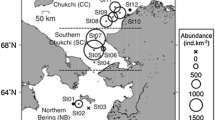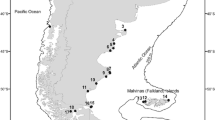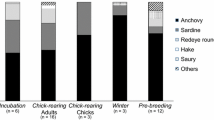Summary
I describe the winter diets (early March) of four seabird species, black-legged kittiwake (Rissa tridactyla), northern fulmar (Fulmarus glacialis), glaucous gull (Larus hyperboreus) and Brüinnich's guillemot (Uria lomvia) collected in the south eastern Barents Sea, in open water approximately 70 km from the ice edge. All species preyed heavily on commercial fish species such as cod (Gadus morrhua), polar cod (Boreogadus saida) and redfish (Sebastes marinus/S. mentella). The median total length of fish eaten ranged from 51 mm in fulmars to 88 mm in Brünnich's guillemots and differed significantly among all species pairs except kittiwake and glaucous gull. Although the size of fish eaten differed among the four bird species they all fed upon much the same age categories of fish. Cod and redfish eaten were almost exclusively one year old, whereas polar cod was 1–4 years old. Other important food items were crustaceans (B\(\ddot r\) unnich's guillemots), and squid Gonatus sp. (fulmars); the glaucous gull also preyed on other birds. Body weights and amounts of stored fat suggest that individuals of all species except Brüinnich's guillemots were in good physical condition. The diets described here differed substantially from those of birds caught mainly during the prelaying season near the colonies in this area. Some of these differences may be attributed to the very low density of capelin (Mallotus villosus) when this study was conducted.
Similar content being viewed by others
References
Abrams NJ, Brown CR (1989) Dietary differentiation and trophic relationships in the sub-Antarctic penguin community at Marion Island. Mar Ecol Prog Ser 57:249–258
Anker-Nilssen T Bakken V, Strann K-B (1988) Konsekvensanalyser olje/sjøfugl ved petroleumsvirksomhet i Barentshavet sør for 74° 30′N. Viltrapport 46:1–99
Ashmole NP (1971) Sea-bird ecology and the marine enviroment. Avian Biol 1:223–286
Bakken V (1990) The distribution and diel movements of Brünnich's guillemots Uria lomvia in ice-covered waters in the Barents Sea in February/March 1987. In: Erikstad KE, Barrett RT, Mehlum F (eds) What determines the distribution of seabirds at sea. Polar Res 8:55–59
Barrett RT (1979) Small oil spill kills 10–20000 seabirds in north Norway. Mar Poll Bull 10:253–255
Barrett RT, Vader W (1984) The status and conservation of breeding seabirds in Norway. In: Croxall JP, Evans PHG, Schreiber RW (eds) Status and conservation of the world's seabirds. ICBP Tech Publ 2:323–333
Barrett RT, Fieler R, Anker-Nilssen T, Rikardsen F (1985) Measurements and weight changes of Norwegian adult puffins Fratercula arctica and kittiwakes Rissa tridactyla during the breeding season. Ring Migr 6:102–112
Belopol'skii LO (1957) Ecology of sea colony birds of the Barents Sea. (Transi from Russian, 1961) Israel Prog Sci Transi, Jerusalem, 344 pp
Bergstad OA, Jørgensen T, Dragesund O (1987) Life histroy and ecology of the gadoid resources of the Barents Sea. J Fish Res 5:119–161
Blake BF, Dixon TJ, Jones PH, Tasker ML (1985) Seasonal changes in the feeding ecology of Guillemots Uria aalge off north and east Scotland. Est Coast Shelf Sci 20:559–568
Brown RGB (1985) The atlantic alcidae at sea. In: Nettleship DN, Birkhead TR (eds) The atlantic alcidae. Academic Press, London, pp 384–427
Brun E (1979) Present status and trends in populations of seabirds in Norway. In: Bartonek JC, Nettleship DN (eds) Conservation of marine birds of North America. US Fish Wildl Serv Rap 11. Washington DC, pp 289–301
Diamond AW (1983) Feeding overlap in some tropical and temperate seabird communities. Avian Biol 8:24–46
Dommasnes A, Røttingen I (1985) Acoustic stock measuremnts of the Barents sea capelin 1972–1984- a review. In: Gjøsæter H (ed) The proceedings from the Soviet, Norwegian symposium on the Barents sea capelin, August 1984. Inst Mar Res, Bergen, pp 45–108
Erikstad KE, Vader W (1989) Capelin selection by Common and Brunnich's Guillemots during the prelaying season. Ornis Scand 20:151–155
Erikstad KE, Bustnes JO, Jacobsen O (1988) Duration of shipfollowing by kittiwakes Rissa tridactyla in the Barents Sea. Polar Res 6:191–194
Erikstad KE, Mourn T, Vader W (1990) Correlations between pelagic distribution of common and Brünnich's guillemots and their prey in the Barents Sea. In: Erikstad KE, Barrett RT, Mehlum F (eds) What determines the distribution of seabirds at sea? Polar Res 8:77–87
Furness RW (1984) Seabird-fisheries relationships in the northeast Atlantic and North Sea. In: Nettleship D, Sanger N, Springer PF (eds) Marine birds: Their feeding ecology and commercial fisheries relationships. Can Wildl Ser Spec Publ, Ottawa, pp 162–169
Furness RW, Barrett RT (1985) The food requirements and ecological relationships of a seabird community in north Norway. Ornis Scand 16:305–313
Gabrielsen G, Mehlum F (1988) Thermoregulation in four species of arctic seabirds. J Comp Physiol B 157:703–708
Gaston T, Noble DG (1985) The diet of thick-billed murres in west Hudson Strait and North-east Hudson Bay. Can J Zool 63:1148–1160
Golovkin AN (1984) Seabirds nesting in the USSR: The status and protection of populations. In: Croxall JP, Evans PG, Schreiber RW (eds) Status and conservation of the world's seabirds. ICBP Tech Publ 2:473–486
Hamre J (1986) Bestands- og forvaltningspolitikk for lodde og sild i 1979- og 1980- årene. I seminar om barentshavets ressurser. Rap Norg Fiskarlag/Fiskeridir Havforskningsinst, pp 72–93
Hamre J (1988) The aspects of the interrelation between the herring in the Norwegian Sea and the stocks of capelin and cod in the Barents Sea. Unpublished ICES paper, C M 1988/H:42, 15 pp
Hartley CH, Fisher J (1936) The marine foods of birds in an inland fjord region in west Spitsbergen. J Anim Ecol 5:370–384
Härkönen T (1986) Guide to the otoliths of the bony fishes of the northeast Atlantic. Danbiu ApS Biological Consultants, Hellerup, Denmark, 256 pp
Hulsemann K (1981) Width of gape as determinant of size of prey eaten by terns. Emu 81:29–32
Hyslop EJ (1980) Stomach contents analysis — a review of methods and their application. J Fish Biol 17:411–429
Jobling M, Breiby A (1986) The use and abuse of fish otoliths in studies of feeding habitats of marine piscivores. Sarsia 71:265–274
Jones PH, Blake BF, Anker-Nilssen T, Røstad OW (1982) The examination of birds killed in oilspills and other incidents. A manual of suggested procedure. Unpublished rep, Nature Conservancy Council, Aberdeen
Kaftanovski YM (1938) Colony nesting of the murre and factors causing the death of the eggs and nestlings. Zool Zh 17:695–705 (in Russian)
Lønne OJ, Gulliksen B (1988) Size, age and diet of polar cod, Boreogadue saida (Lepechin 1773), in ice covered waters. Polar Biol 9:187–191
Lydersen C, Gjertz I, Weslawski JM (1985) Aspects of vertebrate feeding in the marine ecosystem in Hornsund, Svalbard. Norsk Polarinst Rapp Ser 21:57 pp
Mehlum F (1990) Seabirds distribution in the northern Barents Sea marginal ice zone during late summer. In: Erikstad KE, Barrett R, Mehlum F (eds) What determines the distribution of seabirds at sea? Polar Res 8:61–65
Mehlum F, Giertz I (1984) Feeding ecology of seabirds in the Svalbard area — a preliminary report. Norsk Polarinst Rapp Ser 16:41pp
Morisita M (1959) Measuring of interspecific association and similarity between communities. Mem Fac Sci Kyushu Univ Ser E 3:65–80
Norderhaug M, Brun E, Møllen GU (1977) Barentshavets sjøfuglressurser. Medd Norsk Polarinst 104:1–119
Røttingen I (1990) Changes in the distribution and abundance of Norwegian spring spawning herring and Barents Sea capelin. In: Erikstad KE, Barrett R, Mehlum F (eds) What determines the distribution of seabirds at sea? Polar Res 8:33–42
Sanger GA (1987) Winter diets of common murres and marbled murrelets in Kachemak Bay, Alaska. Condor 89:426–430
Schneider D, Hunt GL (1984) A comparison of seabird diets and foraging distribution around the Pribilof Islands, Alaska. In: Nettleship, DN, Sanger GA, Springer PF (eds) Marine birds: their feeding ecology and commercial fisheries relationships. Can Wildl Ser Spec Publ Ottawa, pp 86–95
Spring L (1971) A comparison of functional and morphological adaptations in the common murre (Uria aalge) and thick-billed murre (Uria lomvia). Condor 73:1–27
Vader W, Barrett RT, Erikstad KE, Strann K-B (1990) Differential responses of common and thick-billed murres Uria spp. to a crash in the capelin stock in the southern Barents Sea. Avian Biol (in press)
Author information
Authors and Affiliations
Rights and permissions
About this article
Cite this article
Erikstad, K.E. Winter diets of four seabird species in the Barents Sea after a crash in the capelin stock. Polar Biol 10, 619–627 (1990). https://doi.org/10.1007/BF00239373
Received:
Accepted:
Issue Date:
DOI: https://doi.org/10.1007/BF00239373




